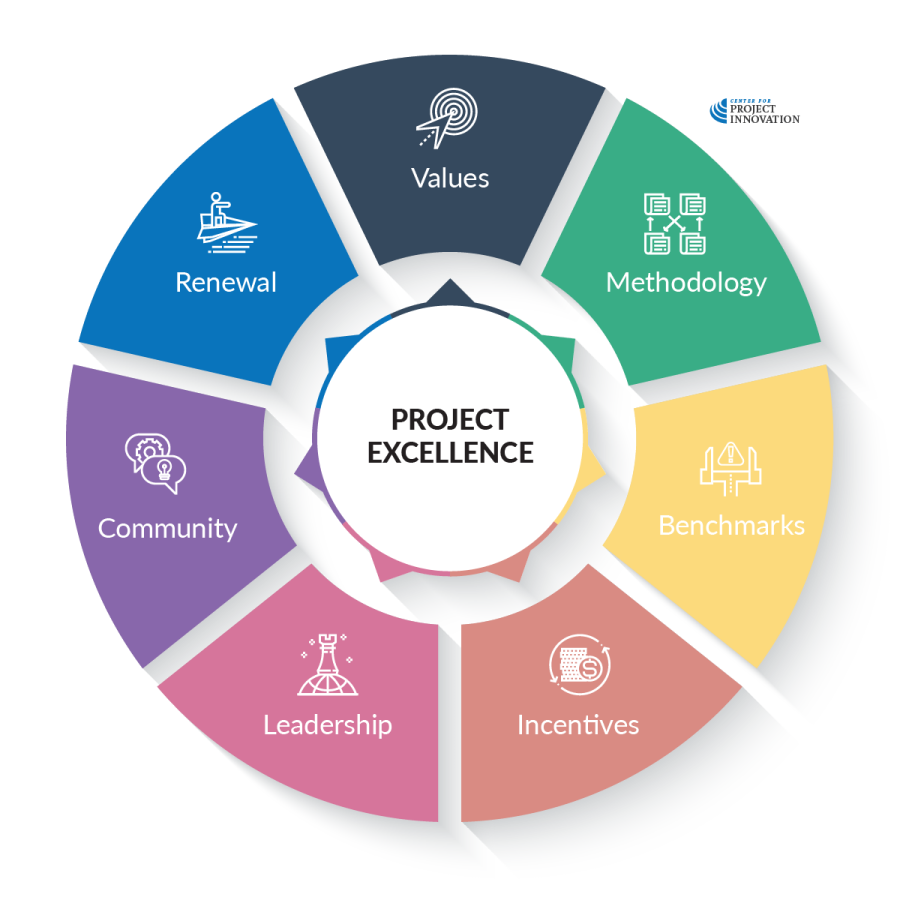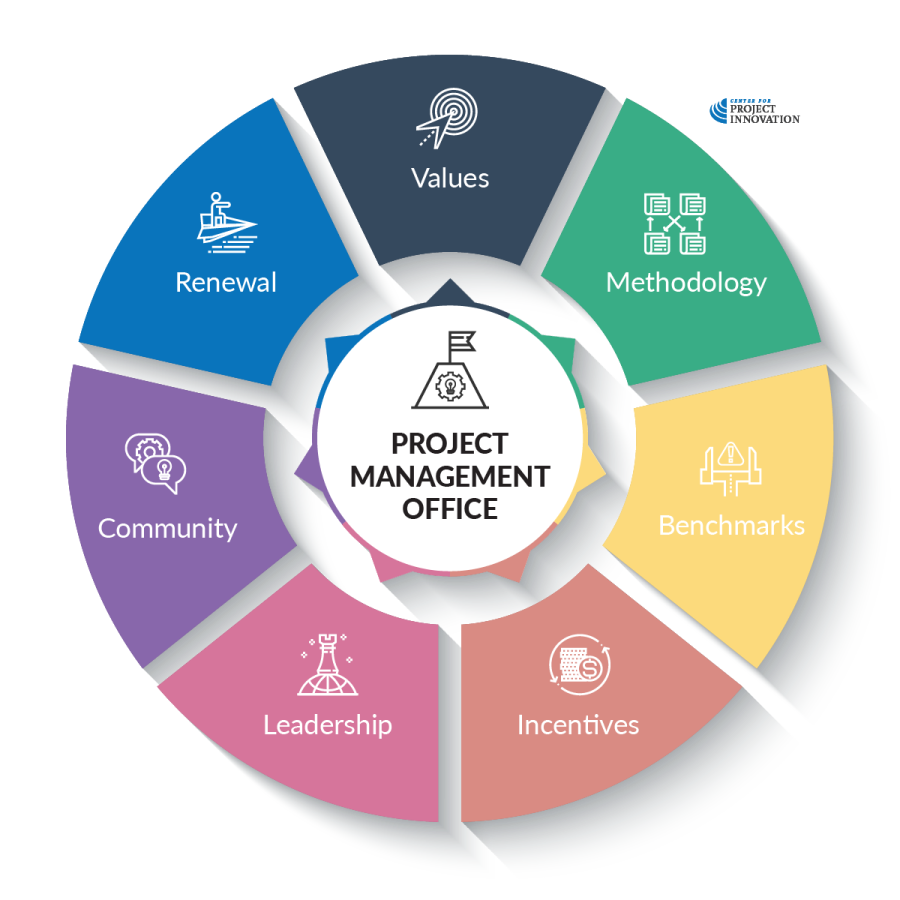Move beyond end-of-project lessons—build daily habits, values, and systems that create a culture of project excellence across your organization.

Success is not final, failure is not fatal—it is the courage to continue that counts.
Anonymous
Key terms
Project excellence: A way of working where teams consistently improve how projects are delivered, not just complete them.
Culture: The shared habits, behaviors, and expectations that shape how people approach project work every day.
Values: Agreed principles that guide how project teams make decisions, act, and interact with others.
Methodology: A structured set of tools, processes, and templates that helps teams deliver projects consistently and effectively.
Benchmarks: Clear performance standards or tolerance ranges that define what “good” looks like in project delivery.
Incentives: Formal or informal rewards that encourage people to apply learning, improve practice, and share insight.
Community of practice: A group of project professionals who regularly share tips, advice, and real-world experience to grow capability together.
Leadership accountability: When sponsors, executives, and steering members take responsibility for outcomes alongside delivery teams.
Renewal: The process of refreshing project teams, practices, and skills so capability remains current and energized.
Project Management Office (PMO): A central function responsible for owning, improving, and coordinating project standards across the organization.
12.8.1: Beyond lessons learned
Continually improving the delivery of projects through lessons learned is the first step toward shifting how your organization approaches project work.
But capturing lessons alone won’t change how people plan, decide, communicate, or take ownership.
Real transformation happens when learning becomes part of how projects are run every day—not a one-off activity at the end.
So how do you create and maintain a culture of project excellence?

1. Values
Just as projects are expected to contribute to the organization’s strategic goals, the way those projects are delivered should reflect the organization’s core values and identity.
If an organization claims to value transparency, collaboration, innovation, or responsibility, those values should be visible in how project teams plan, make decisions, escalate issues, and communicate with stakeholders—not just in policy documents.
Values become meaningful when they move from slogans on a wall to behaviors in daily project practice.
This means translating broad statements like “We value accountability” or “We put the customer first” into clear expectations for project conduct.
At program and portfolio levels, these values can be expressed through SMART objectives, codes of practice, decision-making principles, and ethical guidelines that speak directly to the realities of project work—tight deadlines, competing interests, and shifting scope.
Project excellence begins when delivery teams don’t just “comply” with process but feel aligned with a shared identity.
When values are lived, not just listed, they shape tone, language, and trust across the lifecycle—from how risks are reported to how lessons are shared.
Without clear, lived values, even the best methodologies and tools become mechanical. With them, project delivery becomes a genuine expression of the organization’s character and purpose.
2. Methodology
A methodology on its own won’t fix every project challenge, but having a well-structured set of processes, tools, templates, and decision checkpoints creates a strong foundation for consistent performance.
It gives teams a shared language and predictable rhythm, reducing confusion and helping people focus on delivery rather than reinventing basic steps each time.
However, buying an off-the-shelf methodology or software platform does not automatically create project excellence.
Real value comes when the methodology is adapted to local context, reflecting the organization’s size, culture, governance environment, and stakeholder expectations.
A “copy and paste” approach often leads to low adoption, workarounds, and inconsistent practice. In contrast, a contextualized methodology feels natural to use and aligns with how people actually work.
Consistency is just as important as design. Even the best framework loses impact if it is optional or enforced unevenly.
When tools and templates are used consistently—and reinforced through governance, leadership modeling, and training—they shift from being administrative tasks to being enablers of clarity, accountability, and better decision-making.
A strong methodology is not about bureaucracy—it’s about making it easier for teams to deliver well and for the organization to learn from each project without starting from scratch.
3. Benchmarks
Performance benchmarks give teams a clear sense of what “good” looks like and provide a reference point for fair evaluation.
When benchmarks are realistic and openly discussed, they help project teams understand acceptable variation and make informed decisions without fear of punishment for every deviation.
Nonetheless, within reasonable limits, failure should be tolerated, because it is not realistic to expect complex projects to run perfectly against original estimates.
Organizations that punish any over-budget or behind-schedule performance tend to create a culture of concealment, where issues are hidden rather than raised early.
This not only reduces transparency but also blocks learning and innovation, as people become more focused on avoiding blame than improving delivery.
It’s an overused phrase that failure is a step toward success, but in project environments it holds a practical truth: acknowledging that setbacks will occur allows teams to respond quickly, adjust course, and extract insight without fear.
Benchmarks should guide performance, not serve as weapons.
When used constructively, they provide a baseline for improvement, a way to compare outcomes across projects, and a healthy tolerance band where experimentation and adaptation are allowed.
A culture of project excellence treats benchmarks as learning tools, not just audit criteria.
4. Incentives
Incentives play a powerful role in shaping project behavior.
When people know that effort, growth, and application of lessons will be recognized—not just final outcomes—they become more invested in continuous improvement.
Positive feedback, visible acknowledgment, and fair reward systems signal that learning and collaboration matter just as much as delivery.
Recognition doesn’t always need to be financial; it can be as simple as acknowledging a team that applied past lessons to avoid a known issue or highlighting individuals who shared honest insights in a review session.
What matters most is that recognition is fair, transparent, and shared across the project team—not reserved only for high-visibility roles or those who present well.
Celebrating success without bias or favoritism creates an environment where teams feel valued and motivated to raise their own standards.
When people see that improvement and learning are rewarded—not just hitting deadlines—they are more willing to engage in reflective practice, share insight openly, and push for better project outcomes.
In this way, incentives become more than a thank you—they become part of a feedback loop that drives professional pride and higher quality delivery.
5. Leadership
Leadership sets the tone for how projects are delivered.
When leaders model the behaviors they expect—using the agreed methodology, openly acknowledging lessons, and engaging constructively with review findings—they send a clear message that project excellence is not just the responsibility of delivery teams, but a shared organizational standard.
True leadership accountability means standing alongside project teams in both success and failure.
When things go well, leaders should recognize collective effort rather than credit only decision-makers.
When challenges occur, leaders should help uncover systemic causes rather than assigning blame to individuals.
This approach builds trust and encourages honest reporting, which is essential for meaningful improvement.
Importantly, leadership responsibility extends well beyond the project manager.
Sponsors, steering committee members, executives, and owners all influence project culture through the expectations they set and the behaviors they demonstrate.
When these stakeholders engage thoughtfully with governance processes, support timely decisions, and show willingness to adjust based on lessons, they reinforce a culture where learning and excellence are part of everyday project practice—not just slogans.
Leadership in a culture of project excellence is not about control; it’s about ownership, example, and consistent engagement with the systems that enable better outcomes.
6. Community
Strong project cultures feel more like communities than administrative structures.
Just as successful sporting teams build identity through rituals, shared language, and memorable stories, project-based organizations can harness similar dynamics to build engagement and pride in their delivery culture.
These don’t have to be grand traditions—simple, repeatable rituals like a morning stand-up over coffee, a short After Action Report (AAR) after key milestones, or a quick “what we learned today” moment in team chats can create rhythm and connection.
Community is strengthened when storytelling becomes part of normal project life.
Sharing brief, human stories about what went well—or what nearly went very wrong—keeps lessons alive far more effectively than filing them in a document library.
These stories can be positive, celebrating smart decisions and teamwork, or cautionary, highlighting examples of what not to repeat.
Both types play a role in shaping collective memory and reinforcing values through lived examples rather than policy statements.
By building informal customs, naming shared victories, and retelling project legends—both heroic and humorous—organizations create a sense of belonging around project delivery.
This moves project work from being a series of isolated assignments to a shared professional identity, where people learn from each other and take pride in continually raising the bar.
7. Renewal
High-performing project, program, and portfolio teams don’t just keep moving from one assignment to the next—they pause, renew, and evolve.
Without intentional renewal, even experienced teams can become stale, fixed in their habits, and resistant to new ideas.
Renewal can take many forms: conducting meaningful lessons learned sessions, investing in professional development, or welcoming new members who bring fresh skills and perspectives.
Each new addition or insight becomes a chance to refresh the team’s thinking and keep practices sharp.
However, renewal is not only about adding new input—it’s also about defending the culture you’re trying to build. Behaviors that undermine agreed values, even subtly, should be addressed early and clearly.
When negativity, ego-driven decision-making, or passive resistance is allowed to continue unchecked, it erodes the culture of excellence just as quickly as a failed project can.
Clear boundaries about what is and isn’t acceptable help maintain psychological safety and reinforce shared standards.
A culture of project excellence stays dynamic when teams continuously refresh their knowledge, reflect openly, absorb new energy, and hold each other to a consistent standard of behavior.
Renewal ensures that experience becomes an asset—not a reason to stop improving.
High-performing project, program, and portfolio teams don’t just keep moving from one assignment to the next—they pause, renew, and evolve.
Without intentional renewal, even experienced teams can become stale, fixed in their habits, and resistant to new ideas.
Renewal can take many forms: conducting meaningful lessons learned sessions, investing in professional development, or welcoming new members who bring fresh skills and perspectives.
Each new addition or insight becomes a chance to refresh the team’s thinking and keep practices sharp.
However, renewal is not only about adding new input—it’s also about defending the culture you’re trying to build. Behaviors that undermine agreed values, even subtly, should be addressed early and clearly.
When negativity, ego-driven decision-making, or passive resistance is allowed to continue unchecked, it erodes the culture of excellence just as quickly as a failed project can.
Clear boundaries about what is and isn’t acceptable help maintain psychological safety and reinforce shared standards.
A culture of project excellence stays dynamic when teams continuously refresh their knowledge, reflect openly, absorb new energy, and hold each other to a consistent standard of behavior.
Renewal ensures that experience becomes an asset—not a reason to stop improving.
12.8.2: Practical excellence
Creating a culture of project excellence means turning broad aspirations—like values, leadership, and community—into concrete behaviors and systems that people can see, feel, and participate in every day.
It’s not enough to say “we value good governance” or “we encourage learning.”
Excellence takes shape when those aspirations are translated into visible practices, clear expectations, and repeatable habits across every level of project delivery—from individual contributors to sponsors and executives.
Here’s what that could look like in practice:
Values
- Strategic statement of vision, mission, purpose, and values that guides all project work.
- A clear code of conduct that applies to everyone involved in projects, including external contractors and suppliers.
- Every project explicitly linked to organizational, portfolio, or program-level objectives, so teams understand why their work matters.
Methodology
- Policies, processes, tools, and templates that support every stage of the project lifecycle.
- Frameworks that are scalable and adapted to the organization’s industry, size, and operating environment.
Benchmarks
- Success metrics defined clearly and reported consistently at project, program, and portfolio levels. Examples include:
- Acceptable performance tolerances (e.g., ±10% budget, ±15% schedule).
- Volume and frequency of change requests (indicating planning health)
- Team satisfaction ratings
Incentives
- Project roles defined clearly, with remuneration that matches responsibility and contribution.
- Both formal and informal recognition systems that reward learning, collaboration, and growth—not just hitting deadlines.
Community
- An active project management community of practice where teams share insight, tools, and lived experience. Examples include:
- A Slack or Teams channel where project managers exchange tips, tools, and templates they found useful.
- A live Q&A thread where project teams can post real-time challenges and get peer advice without waiting for formal escalation.
- A shared online board where people recommend podcasts, books, or webinars relevant to project work.
- Peer-led “show-and-tell” afternoons where someone walks through how they, for example, structured a communication plan or managed a procurement.
- Informal “Ask Me Anything” sessions hosted by senior project leaders, sponsors or subject-matter experts.
- Annual lessons learned conference.
Leadership
- A clear governance framework with supporting tools and assets to make decision-making transparent and consistent.
- A defined change management process that supports teams through transitions rather than leaving them to adapt alone.
Renewal
- HR processes that support recruitment, induction, training, performance management, and orderly wrap-up of project teams.
- Defined development pathways for project professionals at all levels, not just senior leads.
- Feedback loops and continual improvement processes that ensure every project feeds into the next, keeping practice fresh and evolving.
12.8.3: The role of the PMO
It’s often said that we learn best from failure, but relying on failure as the primary teacher is the most expensive and painful way to improve.
A mature organization does not wait for mistakes to force change; it takes deliberate responsibility for continual improvement and invests in systems that prevent repeat pain.
That investment is not about “changing culture” by force—people resist change when it feels imposed.
Instead, culture is strengthened by nurturing what already works and giving it structure, visibility, and leadership.
This is where an empowered Project Management Office (PMO) becomes essential.

The PMO acts as the beating heart of a culture of project excellence. It doesn’t just oversee templates or track project status—it takes ownership of the full project ecosystem, including the seven aspirations we’ve listed: values, methodology, benchmarks, incentives, community, leadership, and renewal.
Without a central entity to own, integrate, and refresh these elements, project practices become fragmented, and improvement remains optional.
Most organizations already have pockets of excellence—teams that plan well, communicate clearly, or handle stakeholders brilliantly.
The role of the PMO is to find those high-performing practices, lift them out of isolation, and make them available to everyone.
This turns isolated successes into shared capability rather than one-off achievements dependent on individual personalities.
A mature PMO provides:
- Dedicated ownership of project frameworks, methods, and learning systems.
- Accountability for maintaining relevance and alignment with organizational strategy.
- Oversight of benchmarks, reporting maturity, and risk intelligence across programs and portfolios.
- Support for people, culture, and community-building, not just process compliance.
- Renewal mechanisms to ensure project capability evolves rather than decays through repetition.
In any organization large enough to have departments, it is unrealistic to expect consistent project performance without a dedicated structure to own the project space.
The PMO is that structure.
When positioned as a service-based, enabling function—not an audit or policing entity—it becomes the engine that lifts project delivery from “good enough” to strategic excellence.




